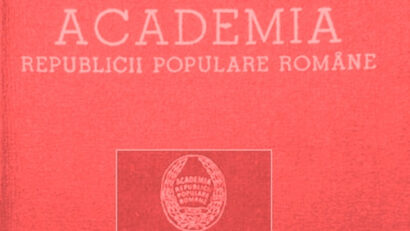The Uranus district
Ninety percent of picturesque Uranus district was lost to communist-era urban planning in the 1980s.

Steliu Lambru, 10.04.2023, 14:00
The area in Bucharest which today comprises the Parliament Palace, the vast Constitution Square and the extensive headquarters of various state institutions emerged in the form we see today in the early 1980s. Almost 40 years ago, this was one of the most picturesque parts of the city, with relatively hilly geography and home to the Army Arsenal building, a stadium, churches and monasteries, private homes, and parks and was known as the Uranus district. 90% of this area was demolished, however, as part of the systematisation policy launched by Nicolae Ceaușescu in 1977.
The historian Speranța Diaconescu, who was working at the time for the Bureau for the National Cultural Heritage of the City of Bucharest, witnessed first-hand the way in which this policy was implemented and how it led to the destruction of many heritage structures and of the entire Uranus district. In an interview to Radio Romanias Oral History Centre from 1997, she remembers that all they were left to do was to archive what was to be demolished:
“The Uranus area in particular, where massive demolitions were conducted, was an old historical area. The Bucharest History Museum wanted to chart it. It was its right and its obligation to chart that old area so wed know what was lost and to retain some trace of it in this way. Later, we extended the mapping beyond Uranus, to all the areas that were demolished. The History Museum of Bucharest has records of the demolished houses, whether poor, shabby houses or palaces. There are records not only of the houses themselves, but of the social and professional situation of their occupants. While not the most detailed of records, they help us form a big picture of the situation at that time.”
Aware of what systematisation really meant, the specialists were making superhuman efforts to rescue what could still be rescued of what was going to be lost. Historian Speranța Diaconescu:
“When the demolition of those areas began, we made lists, under Decree no. 120 from 1981, with proposals about what was to be salvaged from the structures that we going to be pulled down, for example, door knobs, doors or stained windows, or various components of the structure that were of great value. I witnessed some really absurd scenes. We were told that demolition work would begin on a certain street and we were to go there and make an inventory of what needed to be preserved. And we would have done that, except the demolition would begin the next or second day and we didnt even have time to draw up the papers requesting permission to go to the demolition site. We didnt even have a week to decide what should be preserved.”
In fact, the authorities demolition campaign meant destroying what experts recommended to be actually saved, Speranța Diaconescu says.
“I happened to visit various homes that had beautiful parts, windows, crystal-glazed doors, stained-glass doors or mirror doors. As the previous day I had stopped at number 15 and was supposed to continue, the next day I noticed that at numbers 1, 3 and 5 where I had made the suggestion to save the beautiful doors, they were being thrown out in the street. They had started bringing them down, the demolition teams were in a hurry, and all the crystal, all those doors and beautiful windows I recommended for salvaging were broken to smithereens on the curb. I went through other similar experiences, which strengthened my conviction that many of these procedures were just for show”.
After 1989, the main culprit for the destruction of Uranus district was Romanian dictator Nicolae Ceaușescu, who will remain the man people commonly hold accountable. But he was not the only one, Speranța Diaconescu explains.
“Im sorry to have to say it, but the blame for everything that happened fell not just on the head of state. Although everyone thought he was a simpleton, he was clever enough not to sign any demolition orders until after they had been carried out. The demolition decree targeted large areas, then the teams would return to the sites to pull down any remaining monuments under a specially signed order, which the president always signed until after the demolition proper. Therefore, any demolition was carried out only through third parties who were usually threatened with something or wanted to make a name for themselves – and we have plenty of examples in that respect”.
Whatever remains of the Uranus district today is perhaps one of the most beautiful parts of Bucharest. The old district can still be admired in collectors pictures, exhibitions, press articles and social media and in certain documentary and feature films. “Angela moves on”, a 1982 production, is a good example in this respect. (CM & VP)





























